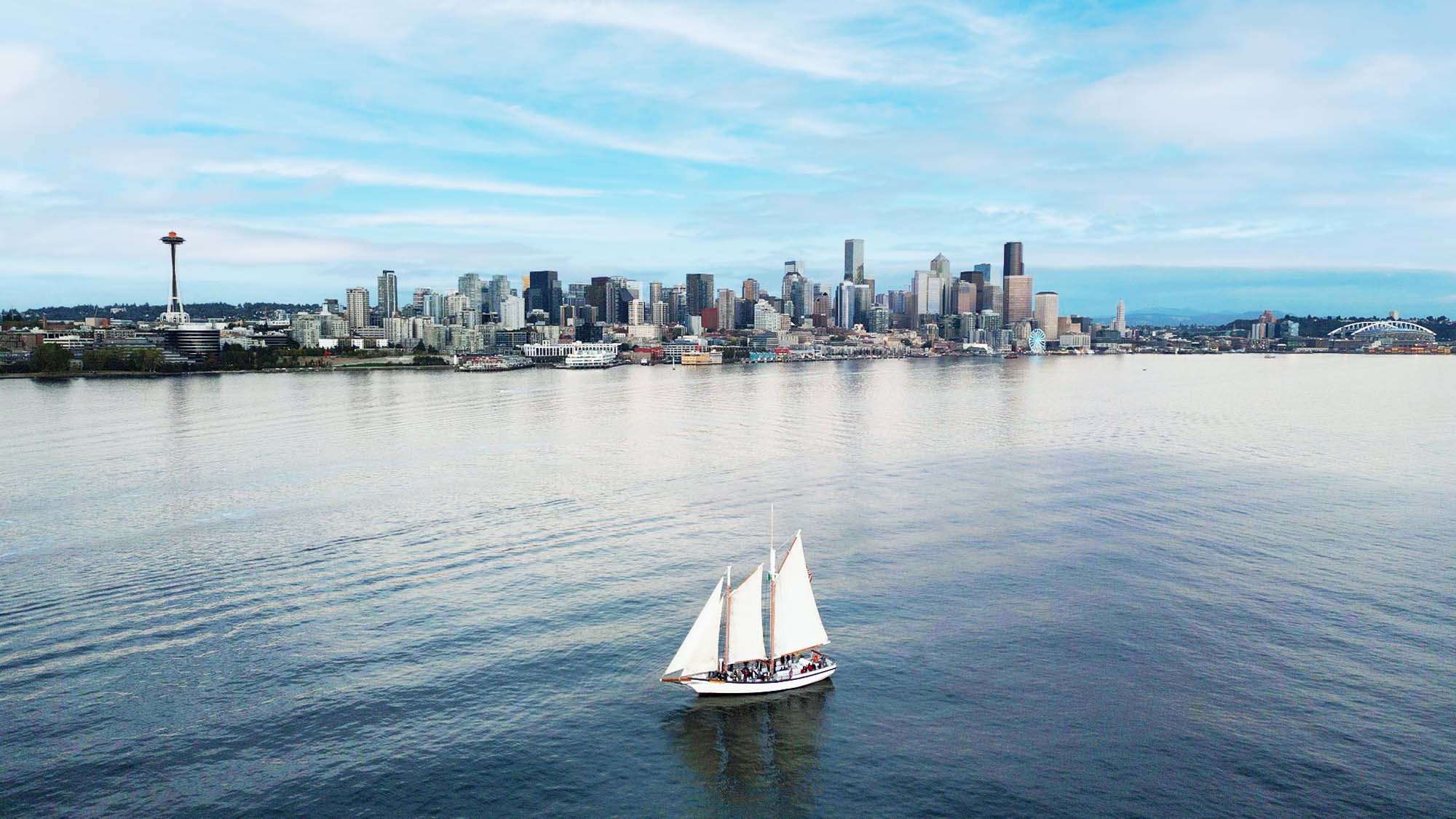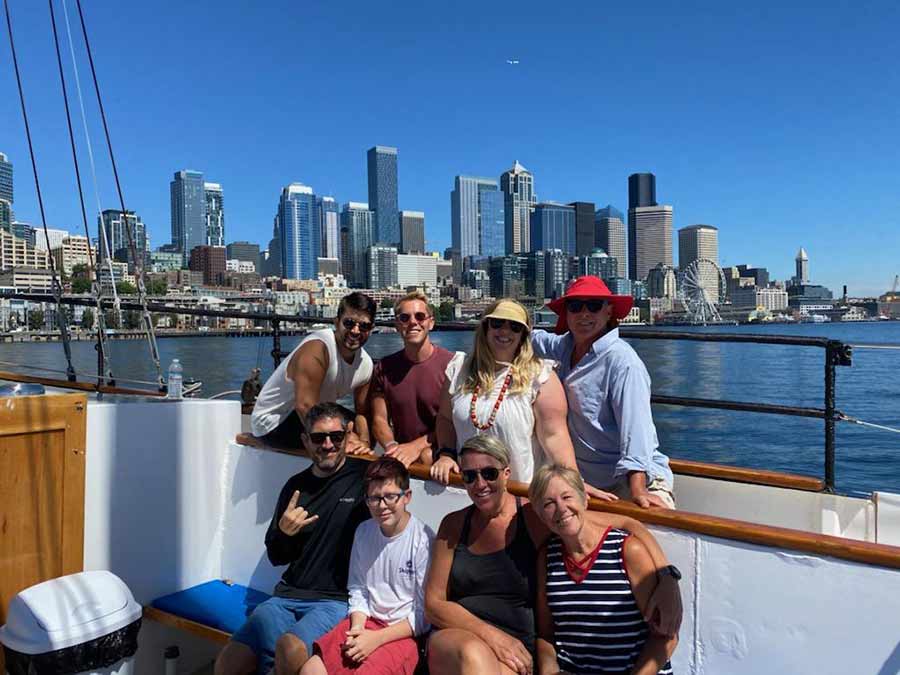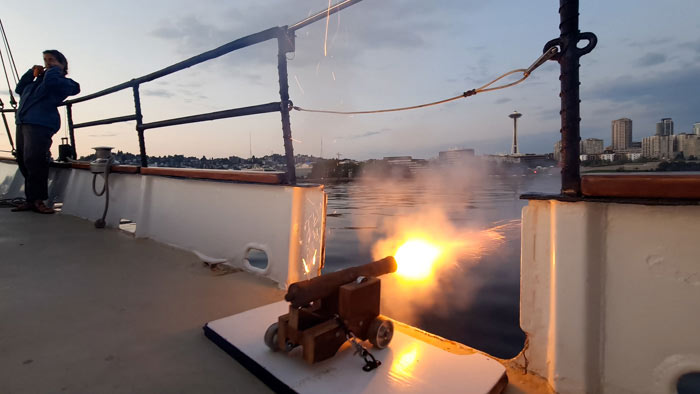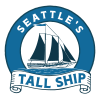
Seattle Waterfront History: From Shipyards to Strolling Paths
Seattle’s waterfront today feels like a postcard come to life. Ferries cruise across Elliott Bay, families wander past sculpture parks and seafood stands, and there’s always someone snapping photos with the Great Wheel in the background. It’s easy to get caught up in the motion and charm of it all.
But just under the surface—sometimes literally—lies a layered story that helped shape the entire city. The Seattle waterfront wasn’t always a place for afternoon strolls and skyline selfies. For much of its life, it was a gritty, working shoreline built on tides, timber, and trade.
This article explores Seattle waterfront history, tracing how a wild stretch of tideflats and timber docks became one of the city’s most beloved public spaces. Along the way, you’ll meet early loggers, Gold Rush merchants, and even a few modern-day sailors still carrying the legacy forward.

A Rugged Beginning — Seattle’s Waterfront in the 1800s
Long before there was a Ferris wheel or a ferry terminal, Seattle’s shoreline was muddy, marshy, and ruled by the tides. When the Denny Party landed at Alki Point in 1851, the area now known as Elliott Bay was covered in tideflats and thick with old-growth forests. The early economy was all about timber. Sawmills popped up near the shoreline, and logs were floated straight into the bay to be processed and loaded onto ships.
By the 1870s, Seattle was growing fast. Wooden piers were built out into the bay to reach deeper water, bypassing the shallows. As the waterfront took shape, it became a rough-edged corridor of warehouses, loading docks, and bunkhouses. The city’s founders reshaped the shoreline with fill dirt and wooden cribbing, gradually taming the tideflats and extending usable land outward.
The shifting, unstable ground led to frequent rebuilding. But the location—protected waters, deep anchorage, and rail access—was ideal. By the end of the 19th century, Seattle had established itself as the Northwest’s primary port and shipping hub.
Learn more from the Seattle Municipal Archives and HistoryLink
The Working Shoreline — Industry, Ships, and Steam
By the early 1900s, the Seattle waterfront was alive with industry. Steamships and sailing vessels docked at long wooden piers that reached into Elliott Bay like fingers. Warehouses stood shoulder to shoulder along Alaskan Way (then known as Railroad Avenue), where tracks ran freight directly to the docks.
Shipyards and canneries boomed. Fishermen brought in daily hauls of cod and salmon, and longshoremen moved freight around the clock. The Klondike Gold Rush in 1897 gave the city another boost as hopeful miners passed through Seattle on their way to Alaska, loading up on gear and provisions.
Northern Pacific and Great Northern rail lines expanded freight operations along the waterfront, and the Port of Seattle was officially established in 1911. Piers like 66 and 91 became major terminals for both cargo and passenger ships. At Smith Cove, coal, grain, and lumber shipments flowed in and out at massive scale.
There was nothing quiet or quaint about the waterfront then. It was the economic engine of the city. Grit, noise, and diesel hung in the air—and the shoreline kept growing as more tideflats were filled to support industry.
Read more from the Port of Seattle.

Looking for an unforgettable day on the water? Seattle’s Tall Ship’s “Bay Lady” offers a unique opportunity to experience the magic of tall ship sailing in the heart of Seattle. Step aboard this magnificent vessel and sail into history as you take in the beauty of Elliott Bay and the Seattle skyline. Don’t miss your chance to embark on a one-of-a-kind adventure—book your sail today!




Guests enjoy the sights and sounds of a tall ship tour onboard Seattle’s Tall Ships, “The Bay Lady”.
Decline and Reimagining — Mid-20th Century to the 1990s
After World War II, changes in global shipping and containerized freight began to reshape port cities. Seattle’s working waterfront started to fade. Large-scale shipping moved to terminals further south, and many of the central piers fell into disrepair.
The construction of the Alaskan Way Viaduct in the 1950s dealt a lasting blow to the connection between city and shoreline. The massive double-decker highway cut off sightlines and walkability. For decades, the waterfront was viewed more as a place to pass through than a place to visit.
Still, a few key projects in the 1970s and ’80s signaled a shift. The Seattle Aquarium opened in 1977. The Waterfront Streetcar offered a scenic ride along the shoreline. Pike Place Market expanded its reach toward the piers, and conversations about public access began to grow louder.
Preservationists and city planners started to imagine a different future for the waterfront—one that welcomed locals and visitors rather than just freight and fish. Slowly, the groundwork for a revitalized waterfront began to take shape.


A New Chapter — Reclaiming the Waterfront for the People
The Nisqually earthquake of 2001 cracked concrete and damaged structures—but it also opened a new path forward. With the Alaskan Way Viaduct deemed seismically unsafe, the city faced a big question: rebuild the elevated highway or try something new?
Seattle chose transformation. After years of planning, debate, and construction, the viaduct was removed, and work began on a redesigned shoreline that prioritized people over cars. New parks, wide promenades, bike lanes, and cultural spaces now fill the stretch where highway pillars once stood.
The Waterfront Seattle Project continues to add features that blend natural beauty with public access: green spaces, pedestrian-friendly piers, local art, and views that were hidden for half a century. With the viaduct gone, neighborhoods from Belltown to Pioneer Square now connect directly to the bay again.
Today, it’s common to see kids chasing seagulls across a plaza, couples sharing coffee with a view, or musicians playing along the sea wall. The transformation isn’t just physical—it’s cultural. The waterfront has returned as a space for community.
See updates and plans at the Waterfront Seattle Project.
History That Sets Sail — Seattle’s Tall Ship Experience
You don’t have to read a museum plaque or imagine the creak of old rigging to connect with Seattle’s maritime past. You can step aboard it. One of the most immersive ways to experience Seattle waterfront history is with Seattle’s Tall Ship, a traditional wooden sailing vessel that departs daily from the heart of the city’s historic piers.
This isn’t a fabricated theme ride or a historic replica with an audio guide. Seattle’s Tall Ship is the real deal—a working tall ship where the sails are hand-hoisted, the wind is the engine, and every creak of the wood tells a story. You’re free to explore the deck, help with the rigging, or just sit back and feel the motion of the bay.
Sailing alongside the skyline and watching it fade into the wake, it’s easy to picture a time when this shoreline was filled with schooners and steamers. The trip offers more than a view—it offers a connection to the city’s roots. And it does so without needing a museum ticket or a textbook.
For anyone looking to experience the living spirit of the city’s maritime heritage, this is your chance to feel it firsthand.

Walking the Past, Today
Seattle’s waterfront is a living timeline. Every piling, every pier, every echo of a ferry horn tells a story about how the city grew, adapted, and opened itself to the world. It’s easy to miss the history underfoot when you’re eating fish and chips or watching the sun drop behind the Olympics—but it’s there.
Next time you’re down by the water, take a moment to notice the details: the shapes of the piers, the lines of old warehouses, the curve of the seawall. And if you want to go even deeper, hop aboard Seattle’s Tall Ship and sail the very same bay that built this city.
There’s no better way to experience Seattle waterfront history.
Book a sail with Seattle’s Tall Ship
If you have never experienced the thrill of sailing on our tall ship, there is no better time to try than now. With multiple sailing times and experiences available, our family-friendly harbor experiences are a must-do Seattle activity. Join us today!
